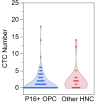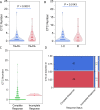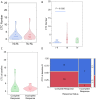Application of circulating tumour cells to predict response to treatment in head and neck cancer
- PMID: 35737211
- PMCID: PMC9219366
- DOI: 10.1007/s13402-022-00681-w
Application of circulating tumour cells to predict response to treatment in head and neck cancer
Abstract
Background: Local recurrence and metastasis remain the major causes of death in head and neck cancer (HNC) patients. Circulating tumour cells (CTCs) are shed from primary and metastatic sites into the circulation system and have been reported to play critical roles in the metastasis and recurrence of HNC. Here, we explored the use of CTCs to predict the response to treatment and disease progression in HNC patients.
Methods: Blood samples were collected at diagnosis from HNC patients (n = 119). CTCs were isolated using a spiral microfluidic device and were identified using immunofluorescence staining. Correlation of baseline CTC numbers to 13-week PET-CT data and multidisciplinary team consensus data were conducted.
Results: CTCs were detected in 60/119 (50.4%) of treatment naïve HNC patients at diagnosis. Baseline CTC numbers were higher in stage III vs. stage I-II p16-positive oropharyngeal cancers (OPCs) and other HNCs (p = 0.0143 and 0.032, respectively). In addition, we found that baseline CTC numbers may serve as independent predictors of treatment response, even after adjusting for other conventional prognostic factors. CTCs were detected in 10 out of 11 patients exhibiting incomplete treatment responses.
Conclusions: We found that baseline CTC numbers are correlated with treatment response in patients with HNC. The expression level of cell-surface vimentin (CSV) on CTCs was significantly higher in patients with persistent or progressive disease, thus providing additional prognostic information for stratifying the risk at diagnosis in HNC patients. The ability to detect CTCs at diagnosis allows more accurate risk stratification, which in the future may be translated into better patient selection for treatment intensification and/or de-intensification strategies.
Keywords: Biomarker, treatment response; Circulating tumour cells; Epithelial-mesenchymal transition; Head and neck cancer; Liquid biopsy; Prognosis.
© 2022. The Author(s).
Conflict of interest statement
All authors have read the journal’s policy on disclosure of potential conflicts of interest. The authors declare that no competing interest exists.
Figures







Similar articles
-
Impact of label-free technologies in head and neck cancer circulating tumour cells.Oncotarget. 2016 Nov 1;7(44):71223-71234. doi: 10.18632/oncotarget.12086. Oncotarget. 2016. PMID: 27655722 Free PMC article.
-
Predicting treatment Response based on Dual assessment of magnetic resonance Imaging kinetics and Circulating Tumor cells in patients with Head and Neck cancer (PREDICT-HN): matching 'liquid biopsy' and quantitative tumor modeling.BMC Cancer. 2018 Sep 19;18(1):903. doi: 10.1186/s12885-018-4808-5. BMC Cancer. 2018. PMID: 30231854 Free PMC article.
-
Short term ex-vivo expansion of circulating head and neck tumour cells.Oncotarget. 2016 Sep 13;7(37):60101-60109. doi: 10.18632/oncotarget.11159. Oncotarget. 2016. PMID: 27517751 Free PMC article.
-
Circulating tumour cells in metastatic head and neck cancers.Int J Cancer. 2015 Jun 1;136(11):2515-23. doi: 10.1002/ijc.29108. Epub 2014 Aug 11. Int J Cancer. 2015. PMID: 25111594 Review.
-
Current Status of Circulating Tumor Cells in Head and Neck Squamous Cell Carcinoma: A Review.Otolaryngol Head Neck Surg. 2023 May;168(5):988-1005. doi: 10.1002/ohn.186. Epub 2023 Jan 19. Otolaryngol Head Neck Surg. 2023. PMID: 36939466 Review.
Cited by
-
The Vitamin D Receptor-BIM Axis Overcomes Cisplatin Resistance in Head and Neck Cancer.Cancers (Basel). 2022 Oct 19;14(20):5131. doi: 10.3390/cancers14205131. Cancers (Basel). 2022. PMID: 36291915 Free PMC article.
-
Emerging histological and serological biomarkers in oral squamous cell carcinoma: Applications in diagnosis, prognosis evaluation and personalized therapeutics (Review).Oncol Rep. 2023 Dec;50(6):213. doi: 10.3892/or.2023.8650. Epub 2023 Oct 20. Oncol Rep. 2023. PMID: 37859591 Free PMC article. Review.
-
Circulating tumour cells predict recurrences and survival in head and neck squamous cell carcinoma patients.Cell Mol Life Sci. 2024 May 23;81(1):233. doi: 10.1007/s00018-024-05269-1. Cell Mol Life Sci. 2024. PMID: 38780775 Free PMC article.
-
Exploiting Vitamin D Receptor and Its Ligands to Target Squamous Cell Carcinomas of the Head and Neck.Int J Mol Sci. 2023 Feb 28;24(5):4675. doi: 10.3390/ijms24054675. Int J Mol Sci. 2023. PMID: 36902107 Free PMC article.
-
Circulating biomarkers in HPV-associated oropharyngeal cancer: Clinical applications of liquid biopsy in diagnosis, prognosis, and surveillance.J Liq Biopsy. 2025 Jul 25;9:100316. doi: 10.1016/j.jlb.2025.100316. eCollection 2025 Sep. J Liq Biopsy. 2025. PMID: 40792229 Free PMC article. Review.
References
MeSH terms
Substances
Grants and funding
LinkOut - more resources
Full Text Sources
Medical

